Photo
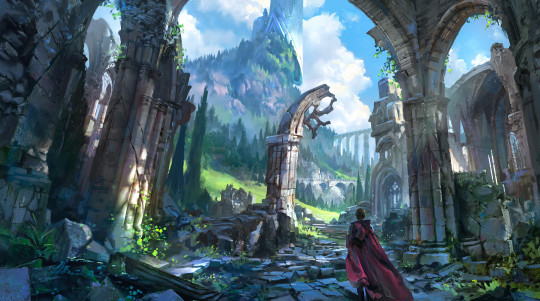
Drafting the Adventure: Dungeons Without Walls
I love the idea of dungeons, but there was a significant portion of my life as a DM where they didn’t feature in my games. While Pathfinder and 5e provided a great framework for character building and tactical skirmishes that I could build story on top of, neither was really great when it came time to detour into a dungeon. My players tended to get confused when we headed out to plunder the local ruin or cave system, spending a lot more time figuring out where they were and what they should be doing than actually doing anything.
The problem as it turned out was limited information. I had a picture of the dungeon in my head/notes but I couldn’t telepathically infer that to the party, and the back and forth questions where they tried to orient themselves within my mental labyrinth ate up a lot of session time prevented us from attaining that snappy pace that every table needs to keep the players invested.
Recently though I had an epiphany about overhauling exploration in d&d, and wrote up a whole post detailing how you could build and run wilderness adventures the same way you could a heist or a murder mystery. Because I was already writing a series about dungeon design it didn’t take long for me to realize that this exploration overhaul was 100% applicable, and could solve a lot of the delay and confusion my players usually faced on their next trip underground. Spoilers: it worked amazingly.
The key to this overhaul was giving my players enough information to see the dungeon as a sort of abstract checklist, and then giving them the power to investigate and check things off that list in whatever order they wished, when they enter a new level of the dungeon they get a new checklist to fill out which still keeps that sense of exploration. Folk love checking things off lists, and I as a dungeonmaster love it when players engage with the content I’ve spent so much energy creating even if it’s only poking their head in the door to realize they want to run away as fast as possible. Likewise, designing the dungeon this way let me tackle much larger concepts without having to sweat the details of filling up every little room as I would have to in map-centric design.
Keep reading
625 notes
·
View notes
Text
+ If you would like to support this blog, please visit my ko-fi and Buy Me A Coffee!
“HEY, Writers!” Ask Policy
I do not answer research questions. Research is the responsibility of the author. Stop asking other writers to do it for you.
What counts as a research question?
Portrayal questions (“How do I write a character who is x?” where “x” is referring to a life experience, physical/mental condition, gender, culture, occupation, etc.)
Specialist/Non-Writing Encyclopedia questions (“Where should my character break their leg to heal within a few months?”, “What technical terms are used in designer fashion?”, “How does child support work?”, etc.)
Whether an idea is offensive/insensitive or not
Location, historical era, or other setting-specific questions
For very simple questions like “how do I…?” please, copy/paste your question into a search engine first. It’s faster.
Check these blogs for answers to questions about…
ethnicity/race @writingwithcolor
fight scenes/combat @howtofightwrite
medical/injury @scriptmedic
disabilities @cripplecharacters
psychology/mental health @scriptshrink
crime/justice @scriptcriminaljustice
various other research topics—The Script Family, @wordsnstuff
ASKS I MAY DELETE!
Requests for my opinion of your concept, for prompts, ideas, names, plot, or dialogue—essentially, don’t ask me to write parts of your story for you—or requests that I read, review, or edit your work (including covers, original drawings, writeblrs, etc.)
Questions I’ve already answered multiple times. This does include writer’s block and self-doubt. Check #writers block #motivation
Non-writing questions, e.g. marketing advice.
Multiple questions within one ask (I do prefer separate asks).
Long, dense asks that I have to dig through to find your question.
Responses to posts I’ve shared—just reply/reblog if you have an opinion!
Magic / occult / supernatural questions.
Sexuality / sex scene / sexual anatomy / erotica questions.
Whiny and/or argumentative statements/questions about something in writing you dislike.
“Signal boost” requests for your post, blog, website, book, charity, etc.*
If I do respond to an ask that violates these guidelines, it doesn’t mean my policy is changing. Do not jump in with more like questions.
If I do not respond to an ask even though it doesn’t violate these guidelines,
Tumblr ate your ask.
It was time sensitive, but I didn’t have time.
You forgot to ask a question entirely—yes, this happens.
I didn’t understand it due to typos, faulty English, etc.
I forgot.
Want to see if I’ve already answered or have shared info relevant to your question?
Check #answer on this blog
Use the search feature
For desktop users, there is a tag list link on the sidebar
I am currently in the process of tag wrangling. If you see I have put tags on a reblogged post, these are usually my archive tags! Click on them for more posts on that subject. If an original post of mine has tags, many of them are just search tags to reach an audience and serve limited use on my blog.
— — —
+ If you would like to support this blog, please visit my ko-fi and Buy Me A Coffee!
1K notes
·
View notes
Text
Character Sheets and character creation →
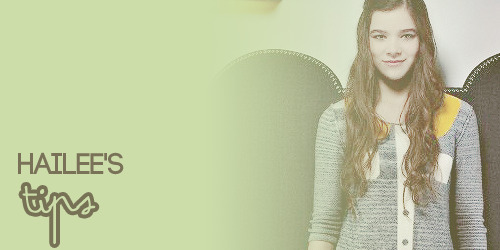
When creating a character, there’s a lot of questions you ask yourself. Whether it’s an original character or one you’ve been playing for a long time, using a character sheet to get to know your character better can always be a nice idea. With it’s help, you’ll be able to think about things you didn’t necesarily thought about, and ask some important questions to yourself that might activate your character’s voice, or help you to get your muse back with them. Everyone has their favorite character sheets, some people prefer to have a lot of questions, some others like it a bit more vague, so here’s a masterlist of the character sheets I found on various websites and found quite interesting, plus some other things that could be used to help you see, for example, how other character view yours.
Blank Character Sheet (+370 Questions)
Abridged Character Sheet (100 Questions)
Big-Ass Character Sheet
Character Creation Form
Character Sheet by Jody Hedlund
Creating a character Bio Sheet
Character Analysis Worksheet
100 Character Development questions for writers
Create a Character Profile
Character Development Worksheet
Original Character Bio-Sheet
Character Chart for Fiction Writers
A Character Chart By Charlotte Dillon
Fiction Writer’s Character Chart
Detailed Character Sheet
Character Sheet Template
Character Twenty-Question Worksheet
In-Depth Character Sheet
Character Worksheet
Character Interview Sheet (First Person)
Background Questionnaire (First Person)
Characters Perceptions (How do other people perceive your character?)
With these sheets, you could also try to find your character’s Jung and Enneagram Type or use the Moral Alignment tool. All of these things can be really useful to get a better grip on a character.
Then, if you’re trying to create a character, and do not have many ideas, or get stuck, I’d suggest for you to roam around TVTropes, which gives you a lot of tropes used for character creation. Maybe you could try to mix a few of these and create an original character?
Or, if you’re a skillful writer and know how to make your character different from another, make a list of characters in fiction you happen to find interesting and why. Try to keep it short. Then, maybe, try to mix and match things from two or three characters, take a character and change their backstory, to see what would change. Play with them to inspire yourself and create something new, original and truly yours.
Oh, and here’s a little guide to Mary-Sues and OCs, just in case you want to make sure your character isn’t going to become a Mary-Sue or a Gary-Stu
And last but not least, this article about building fictional character definitely seemed interesting to me, and is full of many other links that could guide you during the creating of your character and help you file one of these sheets.
#writing#creative#creative writing#fic#fiction#fic writing#fiction writing#nanowrimo#nanowrimo2020#creative fic#creative fiction#author#authors#authorship#character#characters#character development#main character#names#name#plot#plotting#national novel writing month#writeblr#fantasy#fantasy writing
60K notes
·
View notes
Text
i want to follow more writeblr blogs. so uhhh I guess reblog if you’re a writeblr?
852 notes
·
View notes
Photo
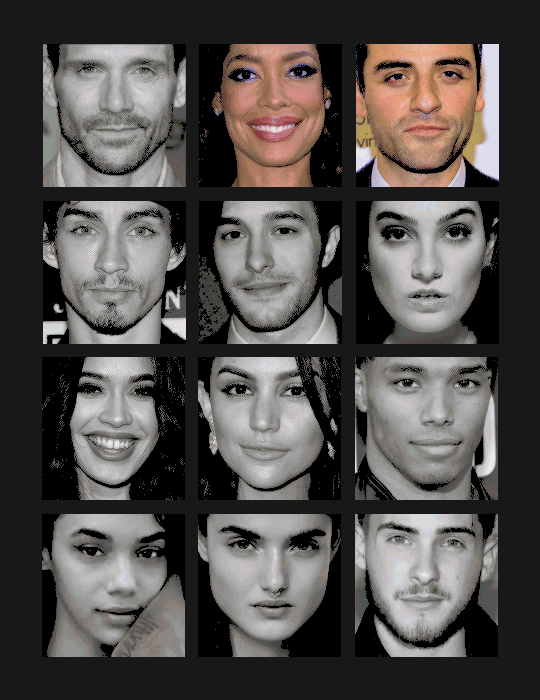
MORBIDRPA’S FAMILY TEMPLATE 001
requested by an anonymous person. i was able to find your male fraternal twin! for alternate casting options and some notes, you can check under the cut! please credit back to this post if you use it in fc help or casting or anything of that nature, LIKE or REBLOG if you found this helpful, and, as always, consider buying me a sleepytime tea for continued support.
father: FRANK GRILLO — white — fifty three years old
mother: GINA TORRES — parts black and cuban — forty nine years old
maternal half-uncle: OSCAR ISAAC — three eights cuban, one quarter guatemalan, one eighth unspecified middle eastern [ sephardic jewish ], one quarter white — thirty nine years old
paternal half-brother: ROBERT SHEEHAN — white — thirty one years old
paternal half-brother: ALEXANDER KOCH — half lebanese, half white — thirty years old
paternal half-sister: NADIA ABOULHOSN — half lebanese, half white — thirty years old
sister: OTMARA MARRERO — parts black and cuban* — twenty nine years old
base: BIANCA SANTOS — parts black, cuban, and white — twenty eight years old
brother: ROME FLYNN — half afro-cuban, half white — twenty seven years old
maternal half-sister: INDYAMARIE JEAN PELTON — parts black, cuban, and cherokee — twenty five years old
paternal half-sister: BLANCA PADILLA — white — twenty four years old
paternal half-brother: CODY CHRISTIAN — three eighths penobscot, five eighths white — twenty three years old
Keep reading
11 notes
·
View notes
Photo









Timothee Chalamet Family Template
Mãe: Marion Cotillard (35-45 anos)
Pai: Mads Mikkelsen (45-53 anos)
Irmão mais velho: Maxence Danet-Fauvel(18-324 anos)
Irmã mais velha: Matilda Lutz (19-27 anos)
Irmã mais nova: Natalia Dyer (16-22 anos)
Irmão mais novo: Graham Verchere (13-17 anos)
Prima: Alexia Giordano (18-26 anos)
Primo: Miles Heizer (16-24 anos)
133 notes
·
View notes
Photo
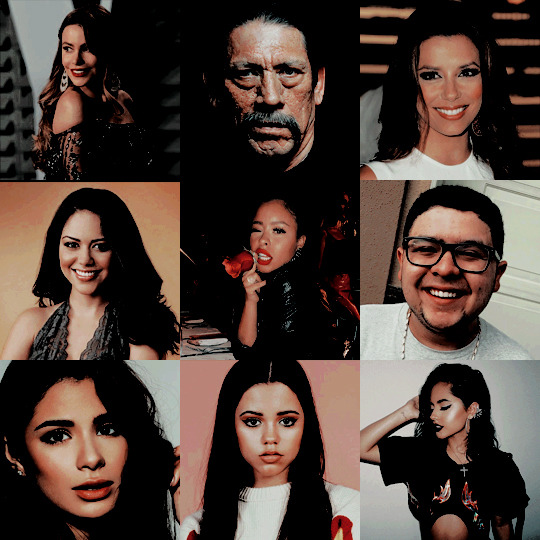
CIERRA RAMIREZ FAMILY TEMPLATE
mother - sofia vergara (46) colombian father - danny trejo (74) mexican aunt - eva longoria (43) mexican older sister - alyssa diaz (33) colombian, mexican BASE - CIERRA RAMIREZ (23) COLOMBIAN, MEXICAN younger/same age half brother - rico rodriguez (20) mexican older half sister/cousin - diane guerrero (32) colombian younger cousin - jenna ortega (16) mexican, puerto rican younger/same age half sister - becky g (21) mexican
135 notes
·
View notes
Text
A Writer’s Family Tree Template
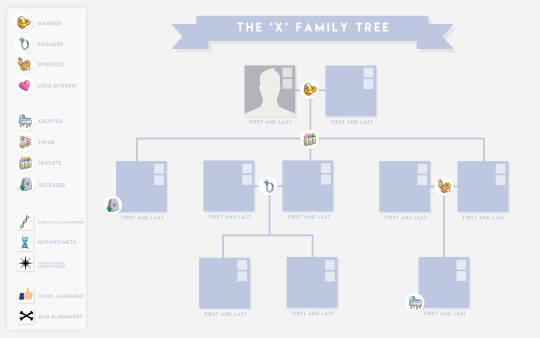
I want to make clear that I did not create this template from scratch. This is modified from a Sims 4 Simblr’s Family Tree template by Smubuh. The original can be found here. All original credit goes to them. I was modifying it for my own use and I thought it might be cool to share mine. [Should the original creator ask me to remove this, I will be doing so. Again, this wouldn’t be possible without their original work.]
This can be used for any kind of writer- a novelist, a screenwriter, a RPer. You have to have an understanding of photoshop layers and shapes, etc. The boxes don’t have to be utilised but some of my projects have super powered humans so I altered the ‘traits’ system for that. Of course you can remove that, remove the photo boxes, not use the symbols, whatever you wish. Go wild!
LINK FOR DOWNLOAD HERE.
You will need to download the LEMON MILK FONT
#reference#references#writingsgoodforthesoul#writing#creative writing#fic#fic writing#creative#fiction#fiction writing#character#characters#family tree#family template
57 notes
·
View notes
Text
It’s time for artists to stop personifying Gluttony as a fat person and start personifying them as a billionaire capitalist who surrounds themselves with luxury at the expense of the poor.
92K notes
·
View notes
Photo
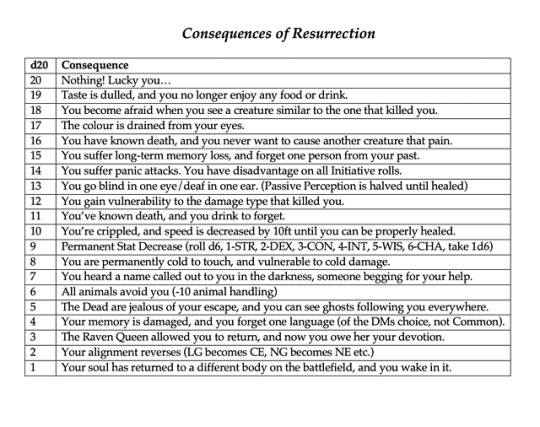
In dnd, resurrecting PCs becomes so easy at higher levels, and though I think that’s a positive, I really like the idea that dying has lasting consequences or triggers events in a PC. Here’s a simple table of interesting but hopefully not game breaking or character destroying ideas. Thoughts? Improvements?
#writingsgoodforthesoul#write#writer#writers#writing#fiction#fic#fiction writing#fic writing#referees#references#resources#resource#creative#creative writ#creative writing
42K notes
·
View notes
Link
#plot#plotting#prompt#prompts#creative#writing#creative writing#fic#fiction#fic writing#fiction writing#writingsgoodforthesoul#theoriginalringding#novel#book#nanowrimo#national novel writing month#victorian#regency#plot ideas#idea#ideas
587 notes
·
View notes
Text
Beta Readers Needed!
Hi All,
I am currently in search of some beta readers for a novel I have been working on for some time. If you have any interest, please message me. I use BetaReaders, the website, which means you can comment, react, etc. right on the website and all my updates will be posted there.
Thank you!!!
2 notes
·
View notes
Text
YA literature? You mean books about Super Special White Girl and Her Mysterious Brooding Boyfriend?
452K notes
·
View notes
Text
Hey :3c…. i need more ppl to follow… so please reblog if you write these things:
LGBT books
Fantasy (preferably with lgbt)
Murder Mysteries
Have books with mysterious deities (idk man,…. love that)
PoC (protagonist of color with any above criteria!! ill be doubly interested if they’re korean,,,,,,,)
Ill follow you!
290 notes
·
View notes
Text

DAY ONE: VACANCY
You’re traveling home. The trip isn’t too long, just a few hours but you had been caught up earlier and left later than you wanted. Night has fallen and the weather wasn’t spectacular. You notice you’ve been yawning a bit too much and focusing on the road is hard.
The road seems to go on and on, you need somewhere to stay for the night. The weather worsens as you give in and pull off the main road heading toward a small town, its names unfamiliar to you. A few more minutes drive and you spot a lit vacancy sign.
You step in the motel shaking off the cold. The lobby’s decor is dated. It’s old, but well kept furniture and wallpaper looking eerily similar to something from your grandparents’ house. A young man stands behind the desk, something about him seems off, but you can’t quite put your tongue on it.
The boy gives you a spin tingling chill as he smiles and bids you welcome.
As you head down the hall to your room, you pass by a young woman carrying a stack of towels. She wears a name tag but you can’t quite make out what it says. She stops when she sees you, her eyes wide. “You shouldn’t stay here,” she says in a stern voice. Her mouth moves to say more, but before she can the boy from the front desk calls for her. She stares for a second longer, then hurries away.
The room is small, quaint in an old fashioned way. You toss your bag on the floor and flop down on the bed. Not five minutes pass when there’s a knock at your door. A sigh escapes you as you get up to open it, tiredly assuming it to be the boy from the front desk, but you hesitate hand hover over the door knob.
There’s a note scratched into the wood, right under the peep hole in the door. it reads, ‘DON’T OPEN TILL MORNING’.
Write a short story about your stay in the motel.
or
Who is the woman with the towels? What does she know about the motel? Why is she working there?
or
Write a piece pitching the motel to potential guests. Lure them in with the motel’s comfort, convenience, and excellence in service. Appeal to them with the promise of the best away from home stay they’ll ever experience. A stay so nice, they may never want to leave.
Looking to share your work on Tumblr? Use the tag #OSWC2018
Challenge INFO
Previous Themes
Questions? Send me an ask!
221 notes
·
View notes
Text
Body Language: Eyes
So I stumbled across this really useful thing which I use for writing and wanted to share it with you all.
(source: changingminds.org)
The eyes are often called, with some justification, ‘the windows of the soul’ as they can send many different non-verbal signals. For reading body language this is quite useful as looking at people’s eyes are a normal part of communication (whilst gazing at other parts of the body can be seen as rather rude). When a person wears dark glasses, especially indoors, this prevents others from reading their eye signals. It is consequently rather disconcerting, which is why ‘gangsters’ and those seeking to appear powerful sometimes wear them.
Looking Up
When a person looks upwards they are often thinking. In particular they are probably making pictures in their head and thus may well be an indicator of a visual thinker.
When they are delivering a speech or presentation, looking up may be their recalling their prepared words.
Looking upwards and to the left can indicate recalling a memory. Looking upwards and the right can indicate imaginative construction of a picture (which can hence betray a liar). Be careful with this: sometimes the directions are reversed — if in doubt, test the person by asking them to recall known facts or imagine something.
Looking up may also be a signal of boredom as the person examines the surroundings in search of something more interesting.
Head lowered and eyes looking back up at the other person is a coy and suggestive action as it combines the head down of submission with eye contact of attraction. It can also be judgemental, especially when combined with a frown.
Looking Down
Looking at a person can be an act of power and domination. Looking down involves not looking at the other person, which hence may be a sign of submission (‘I am not a threat, really; please do not hurt me. You are so glorious I would be dazzled if I looked at you.’)
Looking down can thus be a signal of submission. It can also indicate that the person is feeling guilty.
A notable way that a lower person looks down at a higher person is by tilting their head back. Even taller people may do this.
Looking down and to the left can indicate that they are talking to themselves (look for slight movement of the lips). Looking down and to the right can indicate that they are attending to internal emotions.
In many cultures where eye contact is a rude or dominant signal, people will look down when talking with others in order to show respect.
Looking Sideways
Much of our field of vision is in the horizontal plane, so when a person looks sideways, they are either looking away from what is in front of them or looking towards something that has taken their interest.
A quick glance sideways can just be checking the source of a distraction to assess for threat or interest. It can also be done to show irritation (‘I didn’t appreciate that comment!’).
Looking to the left can indicate a person recalling a sound. Looking to the right can indicate that they are imagining the sound. As with visual and other movements, this can be reversed and may need checking against known truth and fabrication.
Lateral movement
Eyes moving from side-to-side can indicate shiftiness and lying, as if the person is looking for an escape route in case they are found out.
Lateral movement can also happen when the person is being conspiratorial, as if they are checking that nobody else is listening.
Eyes may also move back and forth sideways (and sometimes up and down) when the person is visualizing a big picture and is literally looking it over.
Gazing
Looking at something shows an interest in it, whether it is a painting, a table or a person. When you look at something, then others who look at your eyes will feel compelled to follow your gaze to see what you are looking at. This is a remarkable skill as we are able to follow a gaze very accurately.
When looking at a person normally, the gaze is usually at eye level or above (see eye contact, below). The gaze can also be a defocused looking at the general person.
Looking at a person’s mouth can indicate that you would like to kiss them. Looking at sexual regions indicates a desire to have sexual relations with them.
Looking up and down at a whole person is usually sizing them up, either as a potential threat or as a sexual partner (notice where the gaze lingers). This can be quite insulting and hence indicate a position of presumed dominance, as the person effectively says ‘I am more powerful than you, your feelings are unimportant to me and you will submit to my gaze’.
Looking at their forehead or not at them indicates disinterest. This may also be shown by defocused eyes where the person is ‘inside their head’ thinking about other things.
The power gaze is a short but intense gaze that is used to impose one’s will on another, showing power without aggression.
It is difficult to conceal a gaze as we are particularly adept at identifying exactly where other people are looking. This is one reason why we have larger eye whites than animals, as it aids complex communication.
People who are lying may look away more often as they feel guilty when looking at others. However, when they know this, they may over-compensate by looking at you for longer than usual. This also helps them watch your body language for signs of detection.
The acceptable duration of a gaze varies with culture and sometimes even a slight glance is unacceptable, such as between genders or by a lower status person.
Non-visual gaze patterns (NVGPs) involve rapid movements (saccades) and fixations while we are ‘inside our heads’, thinking. Rapid movements happen more when we are accessing long-term memory and fixations more when we are accessing working memory. This is useful to detect whether people are thinking about older events or recent events (or old events that are already brought to working memory).
Glancing
Glancing at something can betray a desire for that thing, for example glancing at the door can indicate a desire to leave.
Glancing at a person can indicate a desire to talk with them. It can also indicate a concern for that person’s feeling when something is said that might upset them.
Glancing may indicate a desire to gaze at something or someone where it is forbidden to look for a prolonged period.
Glancing sideways at a person with raised eyebrows can be a sign of attraction. Without the raised eyebrow it is more likely to be disapproval.
Eye Contact
Eye contact between two people is a powerful act of communication and may show interest, affection or dominance.
Doe Eyes
A softening of the eyes, with relaxing of muscles around the eye and a slight defocusing as the person tries to take in the whole person is sometimes called doe eyes, as it often indicates sexual desire, particularly if the gaze is prolonged and the pupils are dilated (see below). The eyes may also appear shiny.
Making Eye Contact
Looking at a person acknowledges them and shows that you are interested in them, particularly if you look in their eyes.
Looking at a person’s eyes also lets you know where they are looking. We are amazingly good at detecting what they are looking at and can detect even a brief glance at parts of our body, for example.
If a person says something when you are looking away and then you make eye contact, then this indicates they have grabbed your attention.
Breaking eye contact
Prolonged eye contact can be threatening, so in conversation we frequently look away and back again.
Breaking eye contact can indicate that something that has just been said that makes the person not want to sustain eye contact, for example that they are insulted, they have been found out, they feel threatened, etc. This can also happen when the person thinks something that causes the same internal discomfort. Of course, a break in eye contact can also be caused by something as simple as dried out contacts or any new stimulus in one’s immediate area, so it’s important to watch for other signals.
Looking at a person, breaking eye contact and then looking immediately back at them is a classic flirting action, particularly with the head held coyly low in suggested submission.
Long eye contact
Eye contact longer than normal can have several different meanings.
Eye contact often increases significantly when we are listening, and especially when we are paying close attention to what the other person is saying. Less eye contact is used when talking, particularly by people who are visual thinkers as they stare into the distance or upwards as they ‘see’ what they are talking about.
We also look more at people we like and like people who look at us more. When done with doe eyes and smiles, it is a sign of attraction. Lovers will stare into each others eyes for a long period. Attraction is also indicated by looking back and forth between the two eyes, as if we are desperately trying to determine if they are interested in us too.
An attraction signal that is more commonly used by women is to hold the other person’s gaze for about three seconds, Then look down for a second or two and then look back up again (to see if they have taken the bait). If the other person is still looking at them, they are rewarded with a coy smile or a slight widening of the eyes (‘Yes, this message is for you!’).
When done without blinking, contracted pupils and an immobile face, this can indicate domination, aggression and use of power. In such circumstances a staring competition can ensue, with the first person to look away admitting defeat.
Prolonged eye contact can be disconcerting. A trick to reduce stress from this is to look at the bridge of their nose. They will think you are still looking in their eyes.
Sometimes liars, knowing that low eye contact is a sign of lying, will over-compensate and look at you for a longer than usual period. Often this is done without blinking as they force themselves into this act. They may smile with the mouth, but not with the eyes as this is more difficult.
Limited eye contact
When a person makes very little eye contact, they may be feeling insecure. They may also be lying and not want to be detected.
In persuasion
Eye contact is very important for persuasion. If you look at the other person and they do not look back at you, then their attention is likely elsewhere. Even if they hear you, the lack of eye contact reduces the personal connection.
If you want to persuade or change minds, then the first step is to gain eye contact and then sustain it with regular reconnection.
Staring
Staring is generally done with eyes wider than usual, prolonged attention to something and with reduced blinking. It generally indicates particular interest in something or someone.
Staring at a person can indicate shock and disbelief, particularly after hearing unexpected news.
When the eyes are defocused, the person’s attention may be inside their head and what they are staring at may be of no significance. (Without care, this can become quite embarrassing for them).
Prolonged eye contact can be aggressive, affectionate or deceptive and is discussed further above. Staring at another’s eyes is usually more associated with aggressive action.
A short stare, with eyes wide open and then back to normal indicates surprise. The correction back to normal implies that the person would like to stare more, but knows it is impolite (this may be accompanied with some apologetic text).
When a person stares at another, then the second person may be embarrassed and look away. If they decide to stare back, then the people ‘lock eyes’ and this may become a competition with the loser being the person who looks away first.
The length of an acceptable stare varies across cultures, as does who is allowed to stare, and at what. Babies and young children stare more, until they have learned the cultural rules.
Following
The eyes will naturally follow movement of any kind. If the person is looking at something of interest then they will naturally keep looking at this. They also follow neutral or feared things in case the movement turns into a threat.
This is used when sales people move something like a pen or finger up and down, guiding where the customer looks, including to eye contact and to parts of the product being sold.
Squinting
Narrowing of a person’s eyes can indicate evaluation, perhaps considering that something told to them is not true (or at least not fully so).
Squinting can also indicate uncertainty (‘I cannot quite see what is meant here.’)
Narrowing eyes has a similar effect to constricted pupils in creating a greater depth of field so you can see more detail. This is used by animals when determining distance to their prey and can have a similar aggressive purpose.
Squinting can be used by liars who do not want the other person to detect their deception.
When a person thinks about something and does not want to look at the internal image, they may involuntarily squint.
Squinting can also happen when lights or the sun are bright.
Lowering of eyelids is not really a squint but can have a similar meaning. It can also indicate tiredness.
Lowering eyelids whilst still looking at the other person can be a part of a romantic and suggestive cluster, and may be accompanied with tossing back the head and slightly puckering the lips in a kiss.
Blinking
Blinking is a neat natural process whereby the eyelids wipe the eyes clean, much as a windscreen wiper on a car.
Blink rate tends to increase when people are thinking more or are feeling stressed. This can be an indication of lying as the liar has to keep thinking about what they are saying. Realizing this, they may also force their eyes open and appear to stare.
Blinking can also indicate rapport, and people who are connected may blink at the same rate. Someone who is listening carefully to you is more likely to blink when you pause (keeping eyes open to watch everything you say).
Beyond natural random blinking, a single blink can signal surprise that the person does not quite believe what they see (‘I’ll wipe my eyes clean to better see’).
Rapid blinking blocks vision and can be an arrogant signal, saying ‘I am so important, I do not need to see you’.
Rapid blinking also flutters the eyelashes and can be a coy romantic invitation.
Reduced blinking increases the power of a stare, whether it is romantic or dominant in purpose.
Winking
Closing one eye in a wink is a deliberate gesture that often suggests conspiratorial (‘You and I both understand, though others do not’).
Winking can also be a slightly suggestive greeting and is reminiscent of a small wave of the hand (‘Hello there, gorgeous!’).
Closing
Closing the eyes shuts out the world. This can mean ‘I do not want to see what is in front of me, it is so terrible’.
Sometimes when people are talking they close their eyes. This is an equivalent to turning away so eye contact can be avoided and any implied request for the other person to speak is effectively ignored.
Visual thinkers may also close their eyes, sometimes when talking, so they can better see the internal images without external distraction.
Damp
The tear ducts provide moisture to the eyes, both for washing them and for tears.
Damp eyes can be suppressed weeping, indicating anxiety, fear or sadness. It can also indicate that the person has been crying recently.
Dampness can also occur when the person is tired (this may be accompanied by redness of the eyes.
Tears
Actual tears that roll down the cheeks are often a symptom of extreme fear or sadness, although paradoxically you can also weep tears of joy.
Weeping can be silent, with little expression other than the tears (indicating a certain amount of control). It also typically involves screwing up of the face and, when emotions are extreme, can be accompanied by uncontrollable, convulsive sobs.
Men in many culture are not expected to cry and learn to suppress this response, not even being able to cry when alone. Even if their eyes feel damp they may turn away.
Tears and sadness may be transformed into anger, which may be direct at whoever is available.
Pupil Size
A subtle signal that is sometimes detected only subconsciously and is seldom realized by the sender is where the pupil gets larger (dilates) or contracts.
Sexual desire is a common cause of pupil dilation, and is sometimes called ‘doe eyes’ or ‘bedroom eyes’ (magazine pictures sometimes have deliberately doctored eyes to make a model look more attractive). When another person’s eyes dilate we may be attracted further to them and our eyes dilate in return. Likewise, when their pupils are small, ours may well contract also.
A fundamental cause of eye dilation is cognitive effort. When we are thinking more, our eyes dilate. This helps explain ‘doe eyes’ as when we like others people, looking at them leads to significant thinking about how we may gain and sustain their attention.
Pupils dilate also when it is darker to let in more light. Perhaps this is why clubs, bars, restaurants and other romantic venues are so dingy.
People with dark irises (the colored circle around the pupil) can look attractive because it is difficult to distinguish the iris from the pupil, with the effect is that their dark pupils look larger than they are. People with light irises make the pupils easier to see, so when their pupils actually do dilate then the signal is clearer to detect, making them more attractive ‘at the right time’.
The reverse of this is that pupils contract when we do not like the other person, perhaps in an echo of squint-like narrowing of the eyes. People with small pupils can hence appear threatening or just unpleasant.
Rubbing
When a person is feeling uncomfortable, the eyes may water a little. To cover this and try to restore an appropriate dryness, they person may rub their eye and maybe even feign tiredness or having something in the eye. This also gives the opportunity to turn the head away.
The rubbing may be with one finger, with a finger and thumb (for two eyes) or with both hands. The more the coverage, the more the person is trying to hide behind the hands.
#eyes#writing#writeblr#creative#creative writing#resource#resources#reference#referees#fic#fiction#fiction writing#fic writing#nanowrimo#national novel writing month
21K notes
·
View notes
Photo








A Curse Most Foul - New Bestiary (1/?)
Natherea; also known as Hookclaw, the reigning subspecies of Sarenea. They are as strong as they are hideous and unlike their cousins, the moon and the sun don’t amper their resolve to maim and kill and hunt. Their habitat is the high seas where they are capable of creating thick fogs and storms to sink ships and catch their prey. The Hookclaw diet consists of animals and humans alike. They are a sailor’s greatest fear and the experienced naval general’s best chance. Natherea’s wails will call in reinforcements sometimes over 50 strong.
Continuar a ler
233 notes
·
View notes